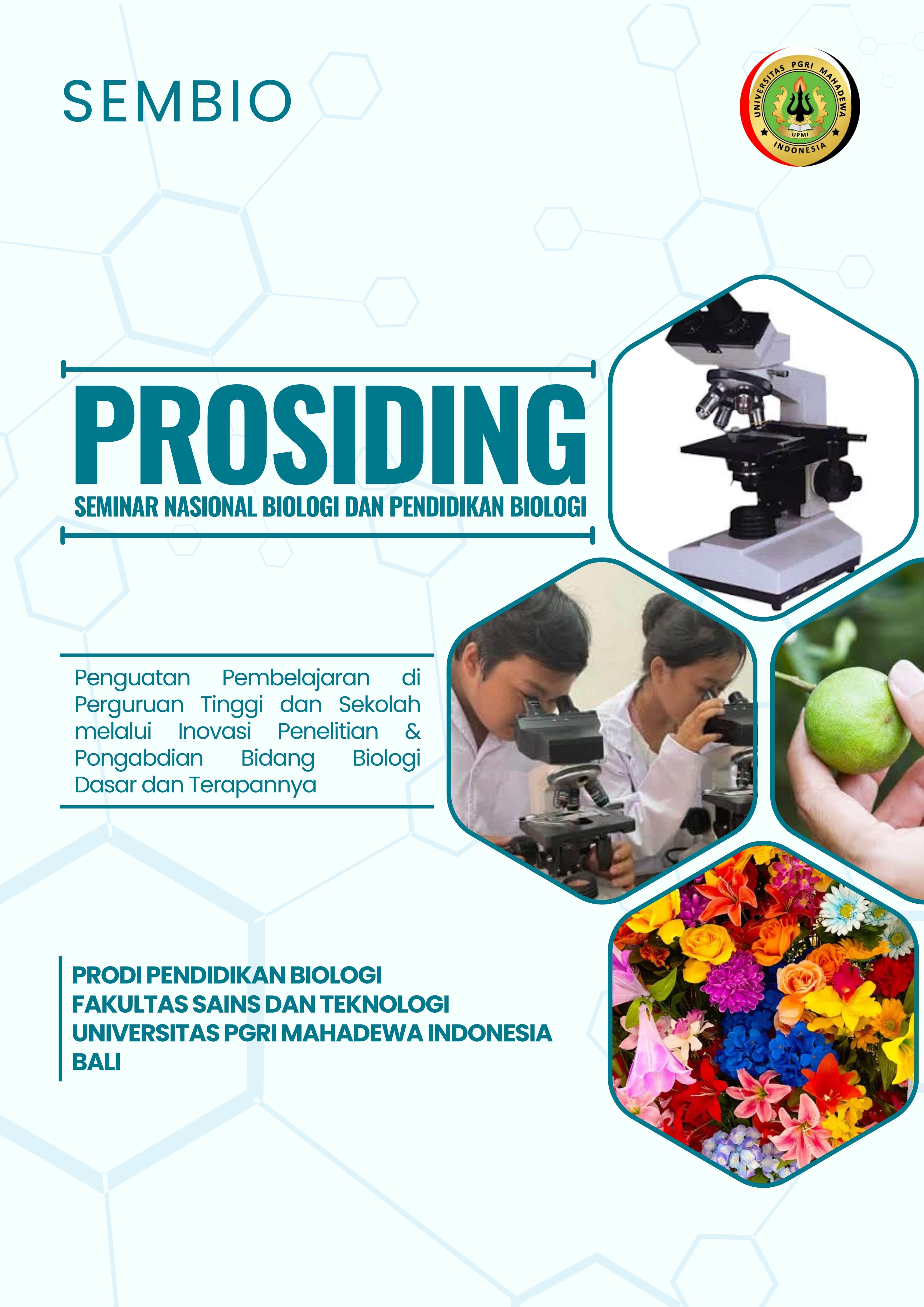KEANEKARAGAMAN SUMBER DAYA HAYATI DAN POTENSINYA SEBAGAI BAHAN PESTISIDA NABATI
DOI:
https://doi.org/10.59672/sembio.v3.4496Keywords:
diversity, biological resources and vegetable pesticidesAbstract
Indonesia is a tropical country that has a variety of soil types, types of climate, both macro and micro climates and other environmental factors, causing Indonesia to have a diversity of biological resources arranged in a high diversity of ecosystems, both natural and artificial ecosystems. Agriculture is an artificial ecosystem that functions to support the lives of farmers socio-economically. An agricultural ecosystem that is less stable will result in a decline in agricultural production and a decline in the health of people who consume agricultural products as the main food ingredient. In agricultural cultivation, controlling pests and plant diseases is absolutely necessary to increase agricultural yields. Vegetable pesticides are pesticides whose active ingredients come from plants or plants and other organic materials which are effective in controlling pest attacks and plant diseases. The ingredients for these vegetable pesticides are sourced from various types of existing plants. The active compounds in these botanical pesticides are biodegradable so they are safe for the health of the environment and consumers.
Downloads
References
Anonim. (2012). Pestisida Nabati dan Cara Penggunaannya. http://media penyuluhan.blogspot.com/2012/06/pestisida-nabati-dan-cara-pembuatannya.html
Azmi Y., Yulistiyono, A., Karyasa, T. B., Putra, R. P., Salama, S. H., Thamrin, N. T., Septiadi, D., Dinata, G. F., Jumiyati, S., & Rizk, F. H. (2022). Pertanian Terpadu. Penerbit PT Global Ekskutif Teknologi.
Dirjen Perkebunan Kementerian Pertanian (2022). Pestisida Nabati sebagai Solusi Pengendalian OPT Tanaman Perkebunan Ramah Lingkungan. https://ditjenbun.pertanian.go.id/pestisida-nabati-sebagai-solusi pengendalian- opt-tanaman-perkebunan-ramah-lingkungan/
Moeljanto, R. D. & Mulyono. (2003). Khasiat & Manfaat Daun Sirih Obat Mujarab dari Masa ke Masa. Jakarta : Agromedia Pustaka.
Kardinan, A. (2005). Pestisida Nabati Ramuan & Aplikasi. Jakarta : Penebar Swadaya. Novizan. (2002). Membuat & Memanfaatkan Pestisida Ramah Lingkungan. Jakarta:
Agromedia Pustaka.
Setiawan, A. (2022). Keanekaragaman Hayati Indonesia: Masalah dan Upaya Konservasinya. Indonesian Journal of Conservation 11(1): 13-21.
Subrata, I. M. (2016). Aktivitas Fungisida Ekstrak Daun Sirih (Piper betle L.) Kultivar Beleng terhadap Jamur Fusarium solani var. coeruleum Penyebab Penyakit Busuk Kering pada Umbi Kentang (Solanum tuberosum L.). Jurnal Emasains 5(2).
Suprapta, D. N. (2001). Senyawa Antimikroba dan Pertahanan Tumbuhan terhadap Infeksi Jamur. Agritrop. 20 : 52-55.
Suprapta, D. N., Suwari, I G. A. N. A., Arya, N. & Ohsawa, K. (2002). Pometia pinnata Leaves Extract to Control Late Blight Disease of Tomato. Journal of ISSAAS 8: 31-36.
Suprapta, D. N., Darmayasa, I B.G., Arya, N., Temaja, I G. R. M., & Ohsawa, K. (2003). Bacterial Activity of Spaeranthus indicus Extract against Ralstonia solanacearum in Tomato. Journal of ISSAAS 9 : 69-74.
Suprapta, D. N. (2005). Pertanian Bali Dipuja Petaniku Merana. Denpasar : Taru Lestari Foundation.
Suprapta, D.N., Subrata, I. M., Siadi, K., Rai, I.G.A., Tunnisa, F. & Ohsawa, K. (2006). Fungicidal Activity of Extract of Several Piperaceae Plants against Fusarium oxysporum f.sp. vanillae. Academic Frontier Research Centre, Tokyo University of Agriculture.
Suwarso E., Paulus, D. R., & Widanirmala, N. (2019). Kajian Database Keanekaragaman Hayati Kota Semarang. https://riptek.semarangkota.go.id/index.php/riptek/article/download/53/50.
Zaka, H. (2008). Pengendalian Hama dan Penyakit dengan Pestisida Nabati. http://isroi.com/2008/06/02/pengendalian-hama-dan-penyakit-dengan-pestisida- nabati/
Downloads
Published
How to Cite
Issue
Section
License
Copyright (c) 2025 SEMBIO: Prosiding Seminar Nasional Biologi dan Pendidikan Biologi

This work is licensed under a Creative Commons Attribution-ShareAlike 4.0 International License.
Authors who publish with the Jurnal Sewagti agree to the following terms:
1. Authors retain copyright and grant the journal the right of first publication with the work simultaneously licensed under a Creative Commons Attribution License (CC BY-SA 4.0) that allows others to share the work with an acknowledgment of the work's authorship and initial publication in this journal.
2. Authors are able to enter into separate, additional contractual arrangements for the non-exclusive distribution of the journal's published version of the work (e.g., post it to an institutional repository or publish it in a book), with an acknowledgment of its initial publication in this journal.
3. Authors are permitted and encouraged to post their work online (e.g., in institutional repositories or on their website) prior to and during the submission process, as it can lead to productive exchanges, as well as earlier and greater citation of published work. (See The Effect of Open Access) .









